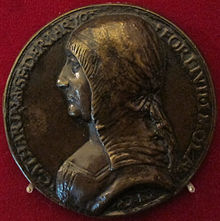
Back كاترينا سفورزا Arabic كاترينا سفورزا ARZ Caterina Sforza BCL Катерина Сфорца Bulgarian Caterina Sforza Breton Caterina Sforza Catalan Kateřina Sforzová Czech Catharina Sforza Danish Caterina Sforza German Αικατερίνη Σφόρτσα Greek
Caterina Sforza | |
|---|---|
| Lady of Imola Countess of Forlì | |
 Caterina Sforza, reproduction of the medal about 1488. | |
| Born | 1463 Milan, Duchy of Milan |
| Died | 28 May 1509 (aged 46) Florence, Republic of Florence |
| Noble family | Sforza |
| Spouse(s) | Girolamo Riario Giacomo Feo Giovanni de' Medici il Popolano |
| Issue | Bianca Riario, Lady of Faenza, Countess and Marchioness of San Secondo Ottaviano Riario Cesare Riario Giovanni Livio Riario Galeazzo Maria Riario Francesco Sforzino Riario Bernardino (later Carlo) Feo Ludovico (later Giovanni) de' Medici |
| Father | Galeazzo Maria Sforza, Duke of Milan |
| Mother | Lucrezia Landriani |
Caterina Sforza (1463 – 28 May 1509) was an Italian noblewoman, the Countess of Forlì and Lady of Imola, firstly with her husband Girolamo Riario, and after his death as a regent of her son Ottaviano.
The descendant of a dynasty of noted condottieri, from an early age, Caterina distinguished herself through her bold and impetuous actions taken to safeguard her possessions from possible usurpers and to defend her dominions from attack, when they were involved in political intrigues. In her private life, Caterina was devoted to various activities, including experiments in alchemy and a love of hunting, dancing, and horse riding. She was educated and engaged in religious rituals and matters, commissioned works of art, stood as a fashion icon, and was a collector of many jewels and clothing. In addition, she undertook urban, residential, and military architectural projects.[1]
While her role as a ruler was considered to be masculine, Caterina had series of portrait medals that embodied her diplomatic skills and political power as a successful regent. At the time, portrait medals were important among the noble society and could be distributed and exchanged as a way to communicate self-presentation, characteristic, and accomplishments of that person. Caterina's first medal represented her beauty, womanly virtue, and conformity to the female role as a noble wife and mother. When Girolamo died, Caterina's next medal represented loyalty and protection of her family with her new position as a chaste widow. While it was feminine, it was also clearly masculine because it represented her additional powerful position as a regent.[2]
She had many children, but only the youngest, Captain Giovanni delle Bande Nere, inherited his mother's forceful, militant personality. Caterina's resistance to Cesare Borgia meant she had to face his fury and imprisonment. After she gained her freedom in Rome, she then went on to lead a quiet life in Florence. In the final years of her life, she confided to a monk: "Se io potessi scrivere tutto, farei stupire il mondo" ("If I could write everything that happened, I would shock the world").
A recent study brings to the forefront and supports the so far little-followed hypothesis of its allegorical representation in the form of the Lady with an Ermine painted by Leonardo da Vinci.[3][4]
- ^ Vries, Joyce de (2010). Caterina Sforza and the Art of Appearances: Gender, Art and Culture in Early Modern Italy. Routledge. p. 1. doi:10.4324/9781315260822. ISBN 9781315260822.
- ^ Cite error: The named reference
:5was invoked but never defined (see the help page). - ^ Xavier d’Hérouville & Aurore Caulier (2023). "Caterina Sforza, La Lionne de Romagne, immortalisée sous les traits de La Dame à l'hermine par Léonard de Vinci ?".
- ^ Xavier d’Hérouville & Aurore Caulier (2023). "Escape game à la milanaise : " Le Grand Œuvre du maître anonyme de la Renaissance italienne "".
© MMXXIII Rich X Search. We shall prevail. All rights reserved. Rich X Search